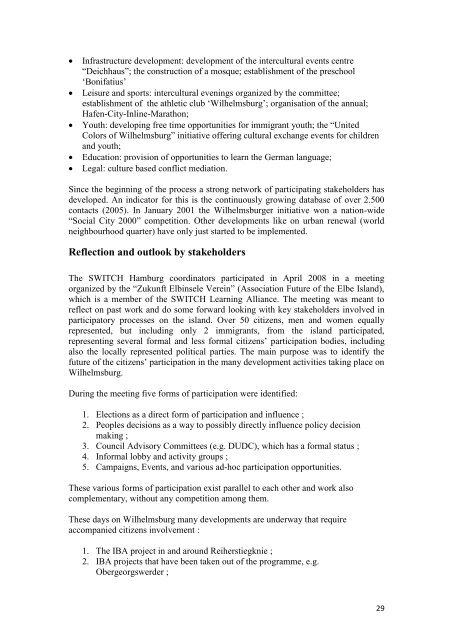Good practices for Social inclusion - Case studies and summary
Good practices for Social inclusion - Case studies and summary
Good practices for Social inclusion - Case studies and summary
Create successful ePaper yourself
Turn your PDF publications into a flip-book with our unique Google optimized e-Paper software.
Infrastructure development: development of the intercultural events centre<br />
―Deichhaus‖; the construction of a mosque; establishment of the preschool<br />
‗Bonifatius‘<br />
Leisure <strong>and</strong> sports: intercultural evenings organized by the committee;<br />
establishment of the athletic club ‗Wilhelmsburg‘; organisation of the annual;<br />
Hafen-City-Inline-Marathon;<br />
Youth: developing free time opportunities <strong>for</strong> immigrant youth; the ―United<br />
Colors of Wilhelmsburg‖ initiative offering cultural exchange events <strong>for</strong> children<br />
<strong>and</strong> youth;<br />
Education: provision of opportunities to learn the German language;<br />
Legal: culture based conflict mediation.<br />
Since the beginning of the process a strong network of participating stakeholders has<br />
developed. An indicator <strong>for</strong> this is the continuously growing database of over 2.500<br />
contacts (2005). In January 2001 the Wilhelmsburger initiative won a nation-wide<br />
―<strong>Social</strong> City 2000‖ competition. Other developments like on urban renewal (world<br />
neighbourhood quarter) have only just started to be implemented.<br />
Reflection <strong>and</strong> outlook by stakeholders<br />
The SWITCH Hamburg coordinators participated in April 2008 in a meeting<br />
organized by the ―Zukunft Elbinsele Verein‖ (Association Future of the Elbe Isl<strong>and</strong>),<br />
which is a member of the SWITCH Learning Alliance. The meeting was meant to<br />
reflect on past work <strong>and</strong> do some <strong>for</strong>ward looking with key stakeholders involved in<br />
participatory processes on the isl<strong>and</strong>. Over 50 citizens, men <strong>and</strong> women equally<br />
represented, but including only 2 immigrants, from the isl<strong>and</strong> participated,<br />
representing several <strong>for</strong>mal <strong>and</strong> less <strong>for</strong>mal citizens‘ participation bodies, including<br />
also the locally represented political parties. The main purpose was to identify the<br />
future of the citizens‘ participation in the many development activities taking place on<br />
Wilhelmsburg.<br />
During the meeting five <strong>for</strong>ms of participation were identified:<br />
1. Elections as a direct <strong>for</strong>m of participation <strong>and</strong> influence ;<br />
2. Peoples decisions as a way to possibly directly influence policy decision<br />
making ;<br />
3. Council Advisory Committees (e.g. DUDC), which has a <strong>for</strong>mal status ;<br />
4. In<strong>for</strong>mal lobby <strong>and</strong> activity groups ;<br />
5. Campaigns, Events, <strong>and</strong> various ad-hoc participation opportunities.<br />
These various <strong>for</strong>ms of participation exist parallel to each other <strong>and</strong> work also<br />
complementary, without any competition among them.<br />
These days on Wilhelmsburg many developments are underway that require<br />
accompanied citizens involvement :<br />
1. The IBA project in <strong>and</strong> around Reiherstiegknie ;<br />
2. IBA projects that have been taken out of the programme, e.g.<br />
Obergeorgswerder ;<br />
29

















